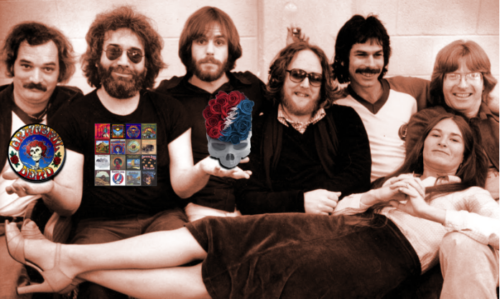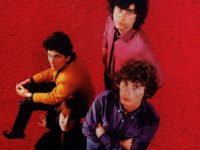
Recently the Daily Beast posted an article about the new documentary on the Grateful Dead: Long Strange Trip, which premiered June 2 on Amazon Prime. The headline for the Beast’s story by Matt Wilstein stated that viewing it will make you a Deadhead.
“No, it won’t,” a few shot back in response to my posting the link on Facebook, with their finality of “and that’s that.” They made it clear that they just didn’t get it. Fair enough, until you consider that they were judging the phenomenon that was the Grateful Dead instead of the actual documentary, which they hadn’t yet seen. Broken into six acts it covers the trajectory of the Grateful Dead, at its center the rise and fall of Jerry Garcia. Overall, it contains enough detail and drama on the history of the band to entertain the uninitiated and followers alike.
Before I go further I must make a confession – no, that word connotes guilt or shame, and neither applies here, so let’s more accurately call it a proclamation: I am a Deadhead. The main reason for the disclaimer is that the title of Wilstein’s article may not actually be pointed at just anyone. It’s directed to those Deadheads like myself, rekindling our enjoyment and wonder of the Dead’s music.
One’s reaction to my declaration may be “Fuck yeah, man!!!” or < rolls eyes >. But like those reactions, there are various stages of Dead-dom in between, and I come just left of center — closer to “fuck yeah, man” but not as fervent as many other believers. I went to shows within my vicinity but didn’t plan far away vacations around them (something I admit I did for Yes, but that’s another set of stories). I obtained Dead show tapes, but didn’t tape many (if any) performances I attended; others would have far better equipment to capture any shows I wanted.
But I dutifully bought the albums, including their studio output. That’s one of the big pieces that is obviously missing from this otherwise fascinating documentary from director Amir Bar-Lev. Early in the film, Phil Lesh comments that he was happy for the Dead to be a working live band and not a “recording act,” eschewing those early battles with Warner Bros. over the lack of any commercial output that could be used to promote those first two albums. Bar-Lev uses that same tact by viewing this tale through the perspective of a performing act.
The fact that Long Strange Trip is mostly from that viewpoint isn’t necessarily a problem. It’s evident that this isn’t a completest look at the Grateful Dead as artists. In fact, it’s hard to miss that Jerry Garcia’s role in this maelstrom is at the film’s core which ends with his death at age 53, and the story had to serve that narrative even if key events had to be jettisoned.
For example, the title of chapter 4 was “Get in the Band,” which was what singer Donna Godchaux advised her husband (and classically trained keyboardist) Keith they should do. But Keith’s death is only mentioned in the context of getting to the next part of the account. While we’re on the subject of keyboard players, Tom Constantin is missing in action, the death of Brent Mydland is fleetingly mentioned, and there is nothing on the keyboardists who accompanied the Dead in the later years (including Bruce Hornsby), and therefore those items in the Dead’s history are nonexistent.
Fortunately, the contributions of singer Ron “Pigpen” McKernan are given appropriate heft. While Pigpen would occasionally perform keyboards, it was his natural talent as front man that would bring audiences to their feet and start dancing. While the rest of the band were experimenting with psychedelic substances, Pigpen (called simply “Pig” by his bandmates) was the sole boozer – and that vice led to his contracting biliary cirrhosis. Sadly, this led to his death in 1973 at age 27.
“He’s Gone” is ingeniously used during the segment covering Pigpen’s tenure, its chorus seemingly appropriate: “Like a steam locomotive going down the tracks, he’s gone, he’s gone, and nothing’s going to bring him back.” But that’s the extent of that song, since the verses don’t apply (e.g., “He’ll steal your face right off of your head”). As Deadheads well know, that song was actually written about drummer Mickey Hart’s father, who ripped off the band. That led to Mickey’s departing the Dead for a couple of years. Omissions like that might not be noticeable to the casual viewer, but are obvious to knowledgeable Deadheads, like myself.
That points to what seems to be an obvious fact: as lengthy as this documentary is, it could have benefitted from another chapter between 4 and 5. The fourth ends with the performances at the Fillmore in 1974 that preceded a much-needed break from the constant touring that occurred up until then. The fifth chapter uses the story of how Deadheads increased in numbers to advance the storyline, taking it well into the 1980s.
Between those two, an additional chapter could have given the viewer an understanding of the Grateful Dead’s artistry and contributions to American songwriting. After the successes of the two studio albums in 1970 (Workingman’s Dead and American Beauty), the Dead would include new songs on the live albums that followed. They would eventually get on track with their studio recordings entering a new era of songwriting, starting with Wake of the Flood and followed by From the Mars Hotel.
The Dead realized that the constant touring was taking their toll, and after a series of shows at the Fillmore in San Francisco the band took a close to two-year break in October 1974. The hiatus allowed the band to set up their own record company and recharge their batteries. Blues for Allah (with its experimental title track) was followed by Terrapin Station, where Grammy-winning producer Keith Olsen mandated that the Dead have their material down tight before going into the studio. The resulting discipline paid off, and the Dead ventured into progressive rock territory with the side-long title track.
Apparently, something had to give to keep Long Strange Trip at a certain length and within budget. In the Daily Beast article, Bar-Lev states that the surviving members wanted to conclude the documentary showing the ongoing activities of surviving Dead members and how they’re carrying on with their musical activities, including the “Fare Thee Well” performances of 2015.
Which brings us back to the Daily Beast article stating the documentary will “make you a Deadhead again.” I’m sure Deadheads remember where they were the day Jerry Garcia died on August 9, 1995. I was on the Windows 95 team at Microsoft, where we had recently completed work on what was to be a huge milestone for the software company, and my career: I was the test engineer who owned two of that operating system’s new components that still exist in Windows 10 more than two decades later: the Task Bar and Start Menu.
That was during a time when Microsoft’s employees celebrated their varied interests through various social aliases, and the one for Grateful Dead was among the largest. After hearing about Jerry’s death early that morning emails were flying between those of us on the distribution, conveying various states of disbelief, shock, and grief. Needless to say, for us not much got done that morning in Redmond, and the other locations around the world.
Those of us on the main campus agreed to gather for lunch at the center fountain to support each other and to together mourn the death of the Grateful Dead’s leader. Eventually, the noon hour was over, and one by one individuals left the fountain to return to their offices. I started to walk away with another grief-stricken ‘Softie — someone I didn’t know outside of the alias, and don’t even remember his name. Neither of us was ready to return to our jobs, so we went into the café in one of the buildings near the fountain and mainly sat in silence, only speaking to convey our despondency. Eventually, I think we gave each other a hug before heading our separate ways.
I can’t speak for Deadheads at large, but when Jerry died so did my enthusiasm for the Grateful Dead. His role was so integral to their music that I lost interest in attending any concerts. The tapes I collected over the years ended up sitting in the garage, gathering dust.
But note that I still have the tapes. That being said I continue to enjoy listening to the studio albums, particularly Terrapin Station. That song is one of many that were adopted by a few then-present and former ‘Softie musicians and friends from Redmond and beyond, who informally gathered at many parties to jam on various Grateful Dead tunes. We informally called ourselves Uncle Bill’s Band, recognizing our collaboration was in part due to our working for the company that was helmed by Bill Gates.
Long Strange Trip might be missing key details, but it is nonetheless full of unseen footage and insightful revelations that makes this journey worthwhile. As a Deadhead in Washington state where recreational cannabis is legal, I admit I altered my consciousness to view the entire documentary over two nights, but that’s beside the point. Beyond the talking heads, I found myself instantly grooving to the omnipresent music of the Grateful Dead heard throughout the soundtrack, and after hearing the stories from the members in old and new footage from the interviews of their crew, colleagues, and family … well, yes, it made me a Deadhead. Again.
Perhaps that last word is what was missing from the Daily Beast article. If you weren’t convinced in the first place then there is no guarantee that by viewing Long Strange Trip you will, I declare, see the light. But for me — and I believe for others like me, who have not been fully engaged with the Grateful Dead since Jerry Garcia’s death – seeing the documentary made me a Deadhead again.
At the very least it brought back why I was, am, and always will be a Deadhead.
©2017 Mike Tiano. All Rights Reserved.
- Remembering Billy James: ‘He Was One of the Good Ones’ - May 15, 2025
- ‘Becoming Led Zeppelin’ (2025): Movie Review - March 11, 2025
- Grateful Dead’s Kennedy Center Honors: What Was Missed - January 27, 2025




